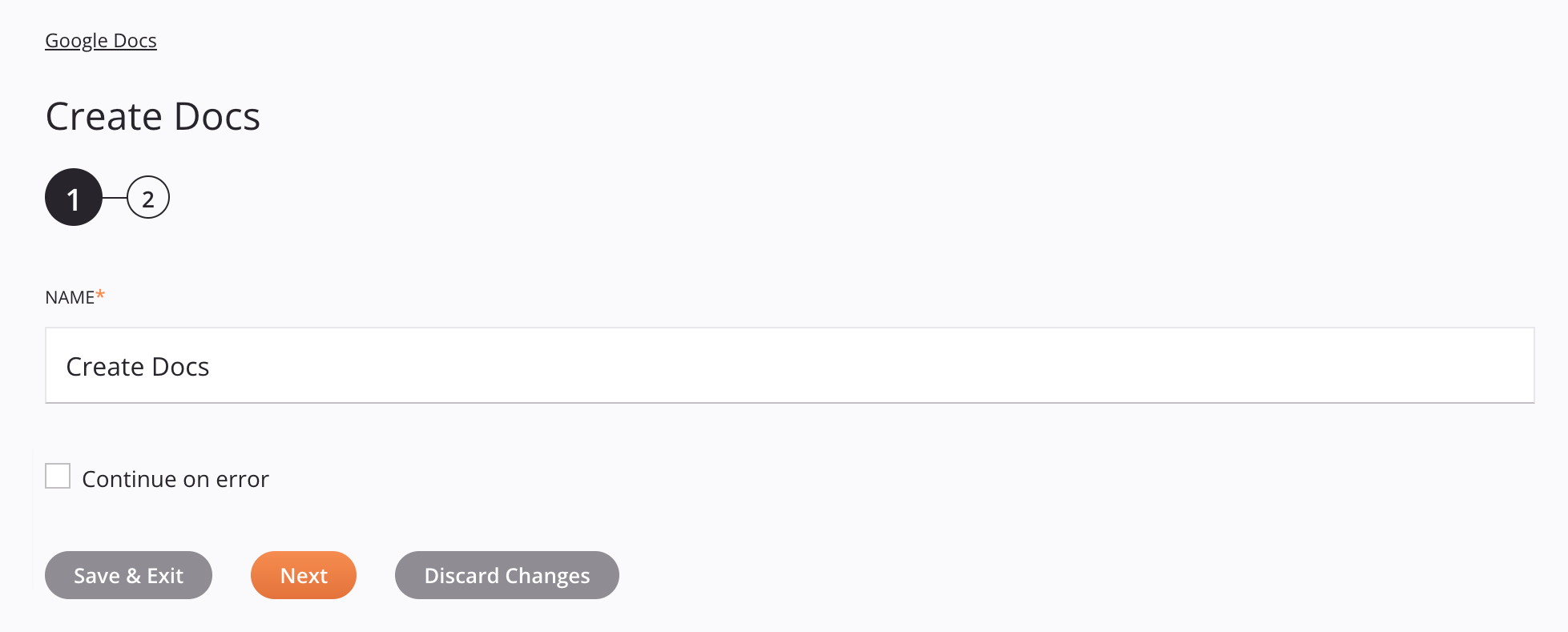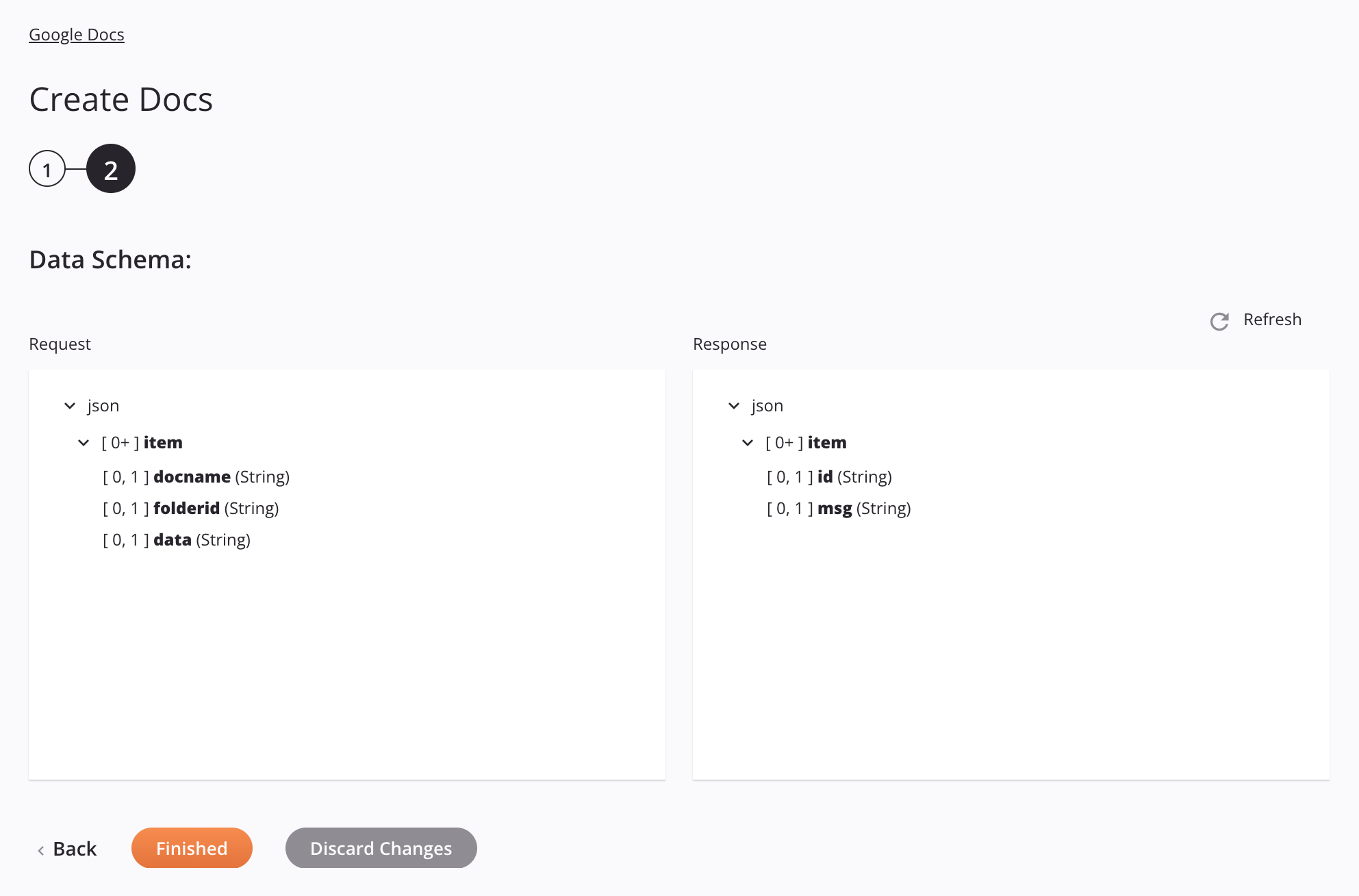Google Docs Create Docs activity¶
Introduction¶
A Google Docs Create Docs activity, using its Google Docs connection, creates documents and places them into Google Docs and is intended to be used as a target to consume data in an operation.
Create a Google Docs Create Docs activity¶
An instance of a Google Docs Create Docs activity is created from a Google Docs connection using its Create Docs activity type.
To create an instance of an activity, drag the activity type to the design canvas or copy the activity type and paste it on the design canvas. For details, see Create an activity instance in Component reuse.
An existing Google Docs Create Docs activity can be edited from these locations:
- The design canvas (see Component actions menu in Design canvas).
- The project pane's Components tab (see Component actions menu in Project pane Components tab).
Configure a Google Docs Create Docs activity¶
Follow these steps to configure a Google Docs Create Docs activity:
-
Step 1: Enter a name
Provide a name for the activity. -
Step 2: Review the data schemas
Any request or response schemas are displayed.
Step 1: Enter a name¶
In this step, provide a name for the activity. Each user interface element of this step is described below.

-
Name: Enter a name to identify the activity. The name must be unique for each Google Docs Create Docs activity and must not contain forward slashes
/or colons:. -
Continue on Error: Select to continue the activity execution if an error is encountered for a dataset in a batch request. If any errors are encountered, they are written to the operation log.
-
Save & Exit: If enabled, click to save the configuration for this step and close the activity configuration.
-
Next: Click to temporarily store the configuration for this step and continue to the next step. The configuration will not be saved until you click the Finished button on the last step.
-
Discard Changes: After making changes, click to close the configuration without saving changes made to any step. A message asks you to confirm that you want to discard changes.
Step 2: Review the data schemas¶
Any request or response schemas are displayed. Each user interface element of this step is described below.

-
Data Schemas: These data schemas are inherited by adjacent transformations and are displayed again during transformation mapping.
The Google Docs connector uses the Google Docs API v1. Refer to the API documentation for information on the schema nodes and fields.
The request and response data schemas consist of these nodes and fields:
-
Request:
Request Schema Field/Node Google API Field Notes itemn/a Zero or more InsertTextRequestsdocnametitleTitle of the Google Doc folder_idn/a Folder ID of the parent of the Google Doc (optional) - If provided, the document is created in that folder
- If not provided, the document is created in the folder shared with the connection service account
datatextText to be inserted using the InsertTextRequest -
Response:
Response Schema Field/Node Google API Field Notes itemdocuments.batchUpdate.responseZero or more responses, one for each request iddocumentIdDocument ID of the Google Doc msgn/a Error messages returned (if any)
-
-
Refresh: Click the refresh icon
 or the word Refresh to regenerate schemas from the Google Docs endpoint. This action also regenerates a schema in other locations throughout the project where the same schema is referenced, such as in an adjacent transformation.
or the word Refresh to regenerate schemas from the Google Docs endpoint. This action also regenerates a schema in other locations throughout the project where the same schema is referenced, such as in an adjacent transformation. -
Back: Click to temporarily store the configuration for this step and return to the previous step.
-
Finished: Click to save the configuration for all steps and close the activity configuration.
-
Discard Changes: After making changes, click to close the configuration without saving changes made to any step. A message asks you to confirm that you want to discard changes.
Next steps¶
After configuring a Google Docs Create Docs activity, complete the configuration of the operation by adding and configuring other activities, transformations, or scripts as operation steps. You can also configure the operation settings, which include the ability to chain operations together that are in the same or different workflows.
Menu actions for an activity are accessible from the project pane and the design canvas. For details, see Activity actions menu in Connector basics.
Google Docs Create Docs activities can be used as a target with these operation patterns:
- Transformation pattern
- Two-transformation pattern (as the first or second target)
To use the activity with scripting functions, write the data to a temporary location and then use that temporary location in the scripting function.
When ready, deploy and run the operation and validate behavior by checking the operation logs.